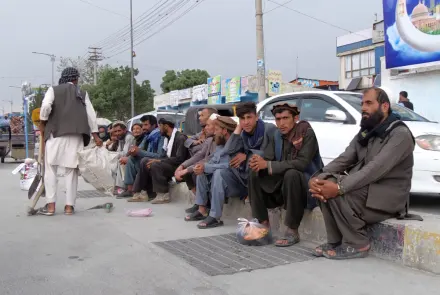The United Nations Development Programme (UNDP) in a report said that Afghans are dealing with extreme hardship, and approximately 85 percent of them live on less than one dollar a day. The situation became markedly worse after August 2021, particularly for women, who are now facing severe restrictions that bar them from education and most jobs, the report said.
It’s stated in the report that the latest UNDP research indicates that the real GDP of Afghanistan has declined by 29 percent since 2020 and continues to spiral downward. The restrictions on women’s rights alone are estimated to have caused an economic loss between US$600 million and $1 billion.
According to the report, UN Assistant Secretary-General and UNDP Regional Director, Asia-Pacific, Kanni Wignaraja, said: “We focus on direct support to women-owned businesses, job creation, basic social services, renewable energy and disaster risk management to keep local economies running, ensure food and energy security, improve people’s wellbeing and protect them from disasters.”
Meanwhile, the World Food Programme (WFP) said that one in three Afghans do not know where their next meal will come from.
The World Food Programme (WFP) in a report said that it urgently needs $670 million to reach 15.2 million men, women and children with lifesaving food, nutrition, and livelihood support.
Stéphane Dujarric, spokesperson for the UN Secretary-General, said: “WFP warns that every province in the country is currently in crisis or worse levels of food insecurity. Previously, large-scale and sustained donor contributions helped carry millions of Afghans through two difficult winters and pulled back more than 5 million people from the brink of famine.”
The Ministry of Economy said that it is trying to solve the economic challenges by attracting investment and supporting domestic production and small businesses in the country.
The spokesman of the Ministry of Economy, Abdul Rahman Habib, told TOLOnews: “The Islamic Emirate tries to bring about employment and work opportunities and the gradual reduction of poverty through the coherence of national policies and programs.”
Earlier, The United Nations Office for the Coordination of Humanitarian Affairs (OCHA), said that 23.7 million people–more than half of Afghanistan’s population–will require humanitarian assistance to survive in 2024 as the country continues to reel from decades of war and grapple with climate-induced crises, recurrent natural disasters, entrenched poverty, and barriers to women’s participation in public life.
On World Labor Day, laborers expressed frustration over their ongoing economic difficulties and high rate of unemployment.
International organizations noted that more than half of the households in Afghanistan are struggling to afford food.
Sediqullah, who is working on a Kabul street, said that he is not able to earn enough money to support his family.
“Sometimes, I walk on the street to find a job, but I cannot earn even 100 Afs,” he said.
The laborers who were interviewed by TOLOnews called on the Islamic Emirate to provide them with job opportunities.
“The unemployment is at its peak. I stay from morning until (the afternoon) but I still go back home with bare hands,” said Ghulam Faroq, a resident of Kabul.
“I find work for one day and then I am jobless for another three days,” said Nabi, a resident of Kabul. The severe economic crisis in Afghanistan has even forced families to send their underage children to work.
The Ministry of Public Works said that more than 150 centers of technical and professional craft professions are active in various provinces of Afghanistan. According to the ministry, around 20,000 staff members are entering the markets. “The Ministry of Public Works is planning to extend these centers to the districts,” said Abdul Wahid Faiz, an official of the ministry.
Meanwhile, the Ministry of Economy said that the construction of major economic projects will provide job opportunities for people.
“In the ongoing year, we try to provide jobs for the youth through supporting small and moderate industries, and also through supporting major economic projects and half-finished projects,” said Abdul Latif Nazari, deputy Minister of Economy.
According to a Report of the International Labor Organization, 900,000 people have become jobless in 2022. However the number of jobless people is expected to increase after the Islamic Emirate banned women from working at NGOs.—Tolonews










